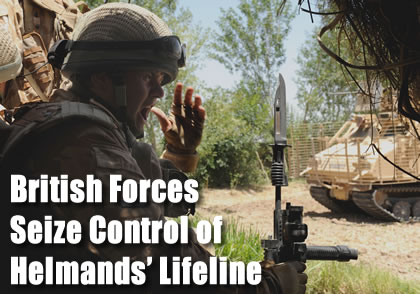
In the latest phase of operation Panchai Palang (Panthers Claw), units of soldiers from the Welsh Guards Battle Group, Light Dragoons Battle Group and 3 SCOTS Battle Group (The Black Watch, 3rd Battalion the Royal Regiment of Scotland) have seized key canal crossing points along the Helmand river irrigation canal and other areas. The soldiers are moving mostly on foot, assisted by Land Rovers, Jackals, Scorpion reconnaissance vehicles, Mastiff armored vehicles which provide fire and logistical support, evacuation and protection when needed. IEDs are the most dangerous threat in the area, during first week, the British lost five soldiers but by the second week of the operation British casualties mounted to 15. The UK operation, with Danish, Estonian and US forces integral to the Task Force, working alongside many other nations in support, is taking place in a heavily-populated area, between Gereshk, the economic hub of Helmand and Lashkar Gah, the provincial capital.

Lieutenant Colonel Nick Richardson, spokesman for Task Force Helmand, said the current campaign is a strategically important operation complementing the US-led Operation Khanjar. “It has several phases, some of which are already completed, others are still to follow. We have made significant progress so far. Having already secured the crossings along two major waterways to the north of Lashkar Gah, we recovered a large number of IEDs, fought back the enemy in several locations and cleared villages along the way.” Col. Richardson said. By improving security and allowing freedom of movement, the operation will also allow reconstruction and development, to take place straight after military operations are complete.
The first phase of the operation began over two weeks ago with some 350 soldiers from 3 SCOTS BG, transported by helicopters to seize key points along the Nahr-e-Burgha canal, some 16km (10 miles) north of Lashkar Gah. The Scottish unit secured three crossing points along the waterway to form a significant barrier to movement for the insurgent forces. Once these points were secured, units from the Afghan National Army, and the Afghan National Police reinforced the Scot’s positions and expanded the the secured area around them, building a new checkpoint position along the main road, to limit insurgent’s freedom of movement in the area.


In the second phase, the Welsh Guards, supported by Afghan troops began moving up the Shamalan canal, seizing 13 canal crossing points as part of the second phase of the operation. Nearer Gereshk, the unit was assisted by Danish forces in capturing further crossings to cover the Welsh Guards’ advance. The Taliban engaged the advancing British troops from nearby compounds with small arms fire and IEDs. In several locations the units encountered enemy opposition, some of it from close quarters, with fire-fights lasting several hours. The Brits responded with guns, light-and heavy machine guns, grenades, shoulder-launched missiles and Javelin missiles, mortars, artillery and air assets, by Apache, Harrier and Tornados. British and US bomb disposal experts removed almost 100 IEDs since the operation began. But some went off undetected causing casualties to the troops.
The third phase began July 3rd, with about 750 troops from the Light Dragoons Battle Group, companies from 2nd Battalion The Mercian Regiment (2 MERCIAN), and Afghan army units sweeping through the area in vehicles and on foot. North of here IED teams from Task Force Helmand recovered in excess of 50 IEDs laid in the area of the Nahr-e-Burgha canal – evidence of the threat that still exists there.
After 10 days in operation Panchai Palang, British forces have suffered significant casualties, compared to losses officially published by other forces. In this period Afghanistan claimed 15 British military lives, mostly around Lashkar Gah, in Helmand, putting the number of dead in that conflict at 184, the Defense Ministry said. The British military has lost 179 soldiers in Iraq. For comparison, in the first 10 days of operation Khanjar, taking place south of the British sector, U.S. Marines suffered four casualties in the Helmand province. Elsewhere in Afghanistan American forces suffered 12 additional deaths in combat operations, mostly from IEDs and attacks on outposts in the east.
- Part I: New Surge Reflects a Fresh Strategy for Afghanistan
- Part II: Changing Strategy for Afghanistan
- Part III: Winning Afghanistan – A Realistic Objective?
- Part IV: Psychological Campaign to Win Civilian Support in Afghanistan
- Part V: British Troops Seize Control of Helmands’ Lifeline the Shamalan Irrigation Canal

















